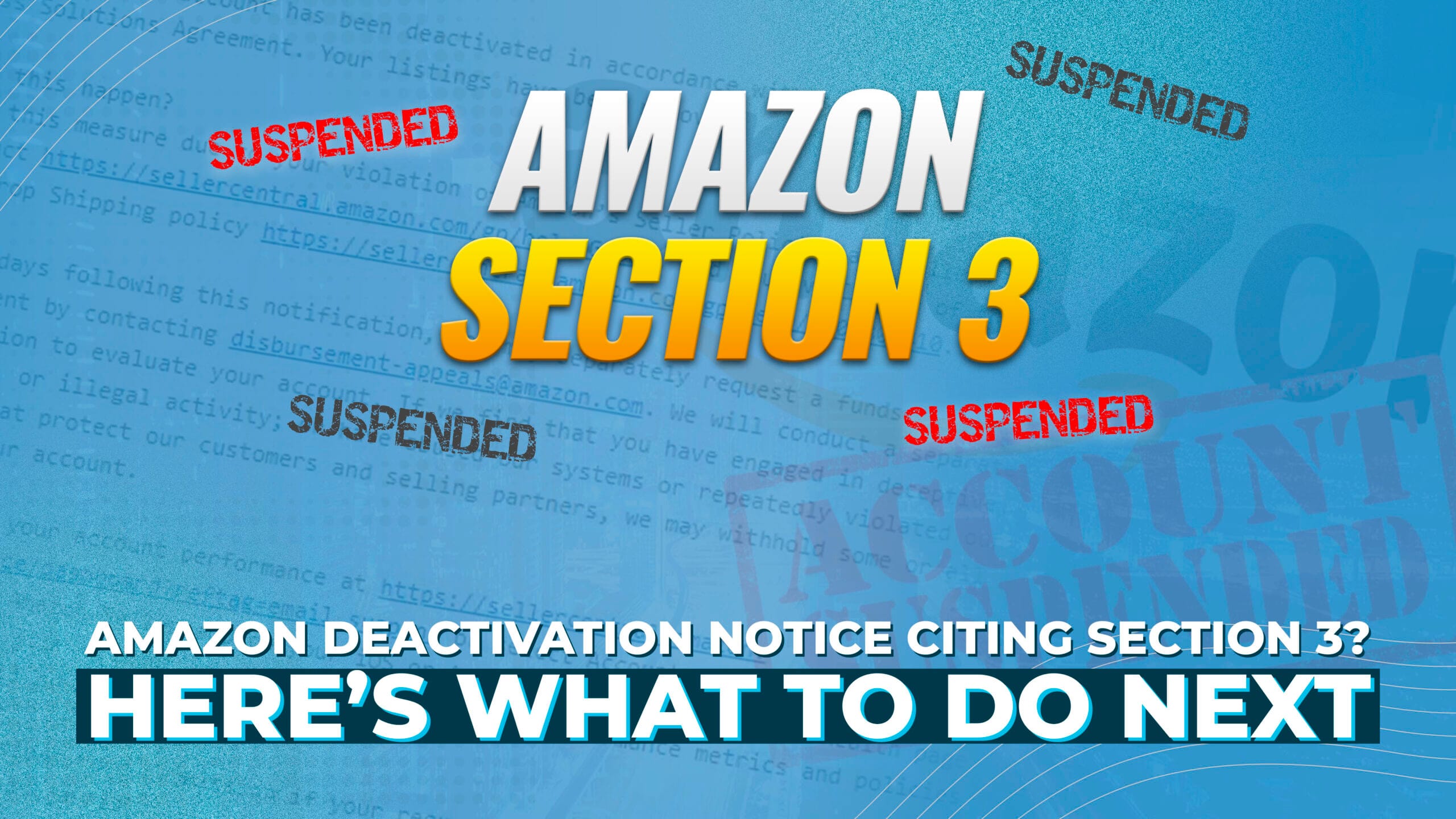You open your Amazon Seller Central dashboard and suddenly feel your heart sink. A blunt, red warning greets you: Your Amazon selling privileges have been removed due to a violation of Section 3 of the Business Solutions Agreement. At first glance, this message appears cryptic. Unfortunately, Amazon’s system rarely provides much context in such notices, leaving sellers confused and overwhelmed.
However, this situation is not rare. Every month, hundreds, if not thousands, of Amazon sellers receive deactivation notices related to Section 3. If you’re one of them, you are not alone, and most importantly, you are not helpless. With the right steps, you can appeal the decision, restore your account, and continue building your e-commerce business.
Understanding Section 3 of Amazon’s Business Solutions Agreement
To navigate your suspension, you must first understand the underlying policy Amazon uses to justify it. Section 3 of the Amazon Business Solutions Agreement gives Amazon broad discretion to suspend or terminate seller accounts. According to the clause, Amazon can immediately revoke access to your selling account if your actions:
“…may result in returns, chargebacks, claims, disputes, violations of our terms, or other risks to Amazon or third parties.”
This intentionally vague phrasing gives Amazon legal leeway to maintain the safety and integrity of its marketplace. However, it also means they can suspend accounts without specifying the exact violation. This ambiguity creates confusion among sellers and makes it harder to identify the root cause without deeper investigation.
In recent years, Amazon has used Section 3 increasingly to combat counterfeit products, performance issues, and policy violations. Reports from Marketplace Pulse show a rising trend in account suspensions, as Amazon continues to prioritize customer trust over seller convenience.
Why You Received a Section 3 Deactivation
Amazon typically does not explain precisely why it deactivated your account under Section 3. However, common causes fall into predictable categories. Sellers often trigger suspensions for issues related to product authenticity, customer satisfaction, or policy violations.
For example, if your order defect rate exceeds Amazon’s threshold of 1%, your account may be deemed high-risk. Similarly, customer complaints about inauthentic goods (even if unfounded) can lead to an account review. Sellers using unknown or non-compliant suppliers may find themselves accused of selling counterfeit or unsafe items.
Additionally, operating multiple seller accounts without written permission from Amazon violates their terms and can lead to swift suspension. Even something as subtle as sharing Wi-Fi with another seller account can cause your store to be linked and flagged.
The bottom line? If Amazon deems your account a risk to customers, it won’t hesitate to act, even preemptively.
You can explore seller experiences and advice on platforms like Reddit’s Fulfillment by Amazon (FBA) community or trusted sources such as WebRetailer.
First Steps After Receiving the Notice
It’s natural to panic when your account gets suspended, especially if Amazon cites Section 3 without clear reasoning. However, your priority should be to remain calm and act methodically.
Begin by carefully reading the entire deactivation message. While Amazon uses standard templates, there may be subtle hints. For instance, terms like “inauthentic,” “poor performance,” or “related account” can guide your next steps.
Immediately after, download all your available data. Amazon may limit access to seller reports during a suspension. Preserve your order history, return reports, performance metrics, and any customer correspondence. These documents will form the evidence base for your appeal.
Next, visit the Account Health Dashboard in Seller Central. This section highlights flagged ASINs, customer complaints, and policy violations. Often, these alerts point directly to the issue Amazon flagged.
You should also refrain from creating a new seller account. Amazon’s detection systems can link accounts via IP addresses, device fingerprints, and even bank account information. Starting a new account may worsen your situation and make reinstatement nearly impossible.
How to Appeal a Section 3 Suspension
Once you’ve identified the likely cause, the next step involves crafting a Plan of Action (POA). This document serves as your formal appeal and is your best shot at reinstating your selling privileges.
Begin your appeal by outlining the root cause. Use the data you gathered to create a clear picture of what went wrong. For example, if customers claimed your products were not as described, point to any misleading listings or issues with your supply chain.
From there, you must detail the corrective steps you’ve already taken. These could include pulling inventory, reviewing supplier certifications, or issuing refunds. Amazon wants to see action, not just promises.
Finally, describe how you’ve implemented long-term solutions. This is critical. You might explain that you’ve adopted a new supplier with better traceability, upgraded your quality control system, or instituted staff training on Amazon policy compliance.
Avoid emotional appeals or vague promises. Amazon responds best to structured, fact-based appeals. For help writing an effective POA, you can consult Amazon-specific legal blogs like Rosenbaum Famularo, PC, or EcomCrew’s Amazon suspension guide. Once ready, submit your appeal through Amazon’s performance notification page, which allows direct uploads and tracking of your appeal’s status.
How Long Does It Take Amazon to Respond?
The response time varies significantly. Some sellers receive feedback within 24 hours, while others wait over a week. If Amazon rejects your first appeal, they typically include feedback. Use this feedback to revise your POA instead of resubmitting the same version.
Persistence pays off. Sellers who thoughtfully revise and improve their appeal often succeed after two or three submissions. Meanwhile, avoid contacting Amazon Seller Support through standard help tickets for these cases; they cannot assist with suspension appeals.
If your appeal remains unanswered after a week, consider following up by replying to the performance notification thread. Be polite, concise, and reiterate that you’ve submitted a compliant and structured POA.
When Should You Hire a Suspension Appeal Expert?
If you’ve exhausted your efforts, you may want to hire an experienced Amazon appeal service. However, this decision should come with caution. Not all appeal services are created equal.
Avoid services that promise guaranteed reinstatement or rely on generic templates. Instead, seek consultants with strong reputations, transparency, and knowledge of Amazon policy trends.
According to The Verge, an entire industry of appeal services has emerged to help sellers navigate Amazon’s automated enforcement. This growth reflects the complexity and seriousness of these suspensions.
What If Amazon Permanently Deactivates Your Account?
In rare cases, Amazon may deny all appeals and close your account permanently. At this point, your options narrow, but they do not disappear.
You can escalate the issue to Amazon’s Executive Seller Relations team by emailing jeff@amazon.com. While Jeff Bezos won’t read your email, the executive response team often does. Sellers have reported success with thoughtful, well-structured escalation letters that include appeal history and supporting documents.
If that fails, you may consider arbitration. Amazon’s Business Solutions Agreement mandates arbitration through the American Arbitration Association (AAA). This process is formal, time-consuming, and often expensive, so it’s advisable to consult a lawyer with Amazon experience.
Legal experts like CJ Rosenbaum specialize in this niche and have helped sellers recover large accounts through arbitration or pre-arbitration settlements.
How to Prevent Future Suspensions
Once reinstated, your goal should shift toward long-term risk management. Begin by monitoring your Account Health Rating (AHR) weekly. Amazon introduced this tool to give sellers better visibility into policy risks, complaint trends, and potential enforcement triggers.
Additionally, always source products from traceable, legitimate distributors. Keep digital and physical records of invoices, supplier contracts, and certifications. In the event of a claim, these documents often make or break your appeal.
Stay educated on Amazon’s evolving rules. Join professional groups like the Amazon Sellers Group on LinkedIn or subscribe to the Amazon Seller Newsletter. These platforms help you anticipate policy shifts and industry trends.
Need Expert Help? Let Brand Aventus Guide You Back to Selling
If your Amazon account has been deactivated under Section 3, don’t navigate the reinstatement process alone. Brand Aventus specializes in Amazon seller account recovery, with a proven track record of crafting tailored Plans of Action that get results.
We don’t use generic templates. We work one-on-one with you to investigate the root cause, communicate effectively with Amazon, and implement compliance measures that protect your brand for the long term.
Contact Brand Aventus today for a free consultation, and let’s get your account back in good standing quickly, professionally, and permanently.




